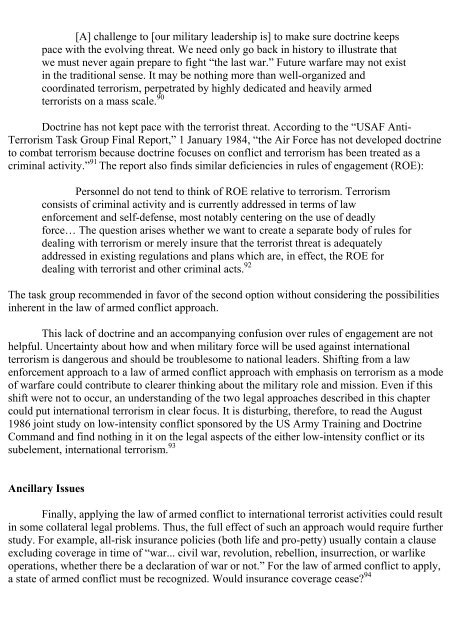Legitimate use of military force against state-sponsored - Air University
Legitimate use of military force against state-sponsored - Air University
Legitimate use of military force against state-sponsored - Air University
You also want an ePaper? Increase the reach of your titles
YUMPU automatically turns print PDFs into web optimized ePapers that Google loves.
[A] challenge to [our <strong>military</strong> leadership is] to make sure doctrine keeps<br />
pace with the evolving threat. We need only go back in history to illustrate that<br />
we must never again prepare to fight “the last war.” Future warfare may not exist<br />
in the traditional sense. It may be nothing more than well-organized and<br />
coordinated terrorism, perpetrated by highly dedicated and heavily armed<br />
terrorists on a mass scale. 90<br />
Doctrine has not kept pace with the terrorist threat. According to the “USAF Anti-<br />
Terrorism Task Group Final Report,” 1 January 1984, “the <strong>Air</strong> Force has not developed doctrine<br />
to combat terrorism beca<strong>use</strong> doctrine foc<strong>use</strong>s on conflict and terrorism has been treated as a<br />
criminal activity.” 91 The report also finds similar deficiencies in rules <strong>of</strong> engagement (ROE):<br />
Personnel do not tend to think <strong>of</strong> ROE relative to terrorism. Terrorism<br />
consists <strong>of</strong> criminal activity and is currently addressed in terms <strong>of</strong> law<br />
en<strong>force</strong>ment and self-defense, most notably centering on the <strong>use</strong> <strong>of</strong> deadly<br />
<strong>force</strong>… The question arises whether we want to create a separate body <strong>of</strong> rules for<br />
dealing with terrorism or merely insure that the terrorist threat is adequately<br />
addressed in existing regulations and plans which are, in effect, the ROE for<br />
dealing with terrorist and other criminal acts. 92<br />
The task group recommended in favor <strong>of</strong> the second option without considering the possibilities<br />
inherent in the law <strong>of</strong> armed conflict approach.<br />
This lack <strong>of</strong> doctrine and an accompanying confusion over rules <strong>of</strong> engagement are not<br />
helpful. Uncertainty about how and when <strong>military</strong> <strong>force</strong> will be <strong>use</strong>d <strong>against</strong> international<br />
terrorism is dangerous and should be troublesome to national leaders. Shifting from a law<br />
en<strong>force</strong>ment approach to a law <strong>of</strong> armed conflict approach with emphasis on terrorism as a mode<br />
<strong>of</strong> warfare could contribute to clearer thinking about the <strong>military</strong> role and mission. Even if this<br />
shift were not to occur, an understanding <strong>of</strong> the two legal approaches described in this chapter<br />
could put international terrorism in clear focus. It is disturbing, therefore, to read the August<br />
1986 joint study on low-intensity conflict <strong>sponsored</strong> by the US Army Training and Doctrine<br />
Command and find nothing in it on the legal aspects <strong>of</strong> the either low-intensity conflict or its<br />
subelement, international terrorism. 93<br />
Ancillary Issues<br />
Finally, applying the law <strong>of</strong> armed conflict to international terrorist activities could result<br />
in some collateral legal problems. Thus, the full effect <strong>of</strong> such an approach would require further<br />
study. For example, all-risk insurance policies (both life and pro-petty) usually contain a cla<strong>use</strong><br />
excluding coverage in time <strong>of</strong> “war... civil war, revolution, rebellion, insurrection, or warlike<br />
operations, whether there be a declaration <strong>of</strong> war or not.” For the law <strong>of</strong> armed conflict to apply,<br />
a <strong>state</strong> <strong>of</strong> armed conflict must be recognized. Would insurance coverage cease? 94
















